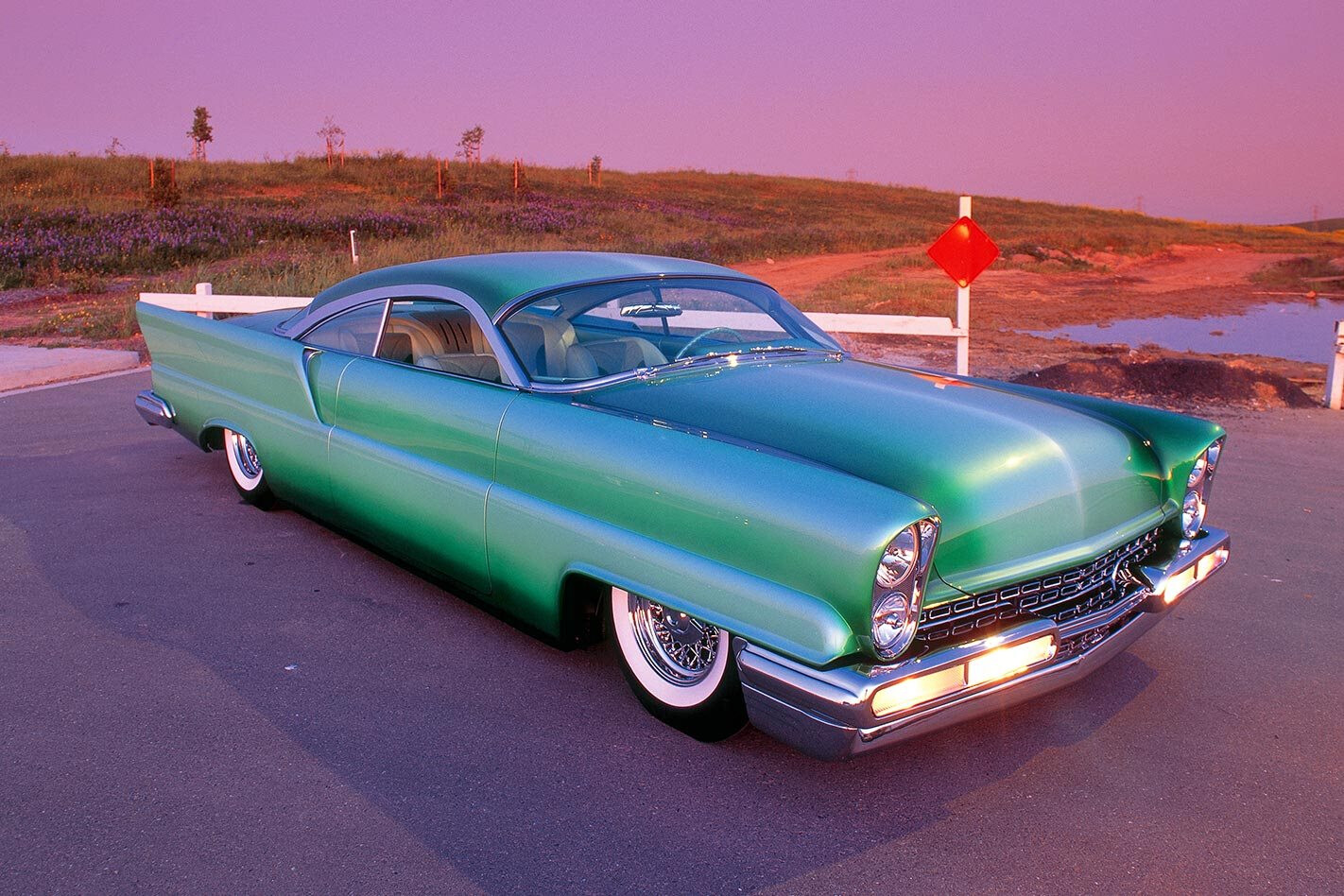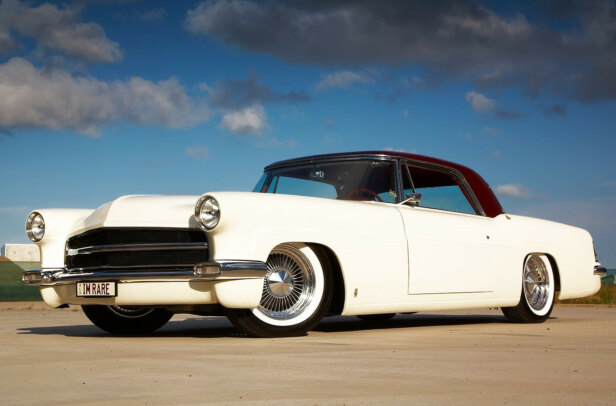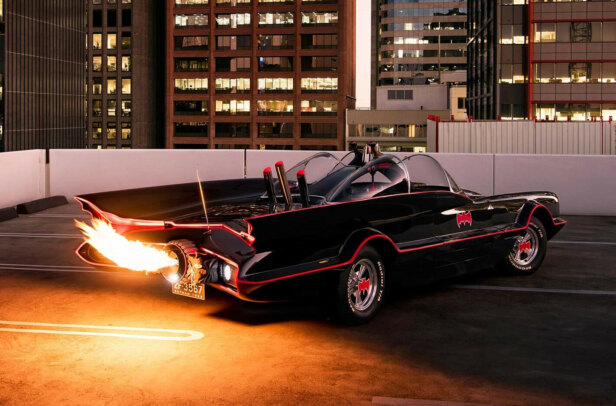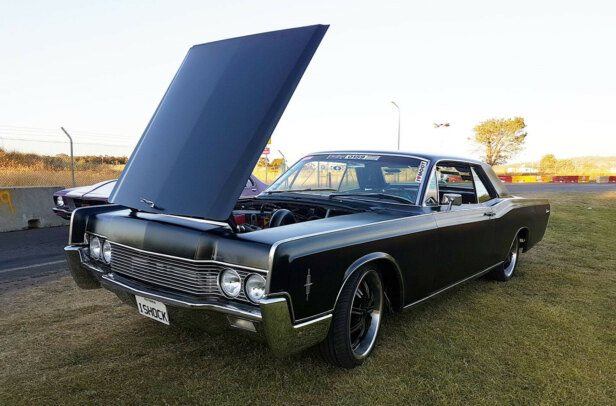This article on John D’Agostino’s Lincoln was originally published in the June 1995 issue of Street Machine
DOES THE shape of this car look familiar? Well, it should if you’ve been a Batman fan for 20 years. The Batmobile was a spin-off from the Lincoln Futura show car, which eventually mutated into the 1956–7 Lincoln Premiere.
John D’Agostino sure wasn’t wearing his decoder ring too tight when he decided to customise this Lincoln Premiere. Mid-50s Lincolns are among Detroit’s forgotten kids, and only in the 90s are guys like John clued into the Linc’s stylish, soft-line shape. In many ways, this generation of FoMoCo products looks just like today’s factory-built customs. The rounded body lines, hooded headlights, lowered chassis, low-brow roof and peaked fins all look custom, straight from the factory.
Mint-green paint is laid on over a white pearl base. Now you know why it looks a mile deep
John wanted more of a concept-car look from the Lincoln, something like the designers would’ve done if they’d kept this body style in 1958. In many ways this was a hard call. He had no choice but to go for major surgery. At Sahagon’s Custom Concepts the roof was chopped five inches at the front and seven at the rear.
Gifted surgeons rebuilt the roofline, requiring custom glass all round
The bodywork was shaved of all trim and chrome, the door handles were lopped and replaced with Unkl Al’s remote openers and the doors, bonnet and bootlid were all rounded off at the corners. The major metalwork was done by Sahagon’s and Gene Winfield. The body is seamless along with rolled and extended bonnet, moulded nose, new grille opening, new rear grille panel, extended rear fins and Frenched tail-lights.
This was not the end of the sheetmetal changes. John also had them French and mould-in the headlights, creating a semi-peak eyebrow at the top. The lower rocker panels were extended while the pretend side scoop in the rear quarter panel was transformed into a real, functioning scoop with a perforated chrome grate. John then built a floating grille from ’59 Mercury parts for the front and rear. Both bumpers were smoothed, rechromed and flush-fitted.
At first glance the wet-feel paint looks rich and vibrant. Gene concocted a mint-green paint using House of Kolor and PPG lacquer. The multi-layered paintwork is built on a pearl green paint, applied over a layer of pearl white to show off the blending. The colour is heavily accented across the flat panels and fades from a solid green to a translucent green at the sides, bonnet, boot and roof. The fade-away look is accented by a light misting of black to heighten the edge of the fade line. According to Winfield, he eventually laid about 30 coats of paint, not including the final few coats of clear.
Wheel is factory – and they sure built ’em big in those days
Sahagon’s designed and fabricated most of the wild, multi-toned green interior. Darryl Hollenbeck customised the dash by removing the crash pad and smoothing out all the manufacturing wrinkles before being coating it in mint green.
The interior is a mix of mint leatherette, Italian velvet and English tweeds to work with the brilliance of the exterior colour. The huge factory steering wheel was painted to match the dash and the stock instruments were retained. John fabricated four bucket seats, moulding the rear ones into a complete installation separated by a full-length console Incorporating a VCR, eight-inch Sony colour TV and a drinks cooler. The Sahagon team then fabricated new door and kick panels, sculpted and moulded headliner and new dark-green carpet.
Seats are custom from the ground up
The Lincoln features its original rebuilt 300hp, 368-cube V8. It is painted in Candy Organic Green with chromed factory air cleaner and the stock FoMoCo automatic transmission to herd the horses to the rear. Suspension was slammed using Winfield’s custom drop spindles, new springs and air shocks.
The rolling stock took John a little time to figure out; he wanted to retain the classic 50s spoked look so he asked Wire Wheels of Fresno, California, to make him a set of ’53–’56 Cadillac wire wheels, capped with ’56 Chrysler Kelsey-Hayes knock-off centre caps. Those handsome wheels turn a set of 820×15 tyres with 2½-inch whitewalls.
At the Oakland Grand National Roadster Show the Lincoln picked up four major awards: Radical Custom, Most Outstanding Full Custom, Best Paint and Best Interior. At the show, John was inducted into the Hall of Fame for “his great work building innovative and beautifully crafted customs”.
Amen to that.




Comments